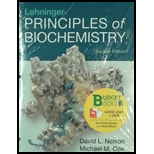
(a)
To determine: Location of 14C in fructose-1,6-bisphosphate.
Introduction:
In the glycolysis process, glucose is catabolized to release energy. Glucose serves as the prime carbon source for the cells. Citric acid cycle is also involved with the release of energy.
(b)
To determine: Location of 14C in glyceraldehyde-3-phosphate.
Introduction:
Glycolysis cycle starts from glucose which is a six carbon membered structure. Fructose-1,6-bisphosphate gets converted into glyceraldehyde-3-phosphate and dihydroxyacetone phosphate. These structures are 3-carbon substances.
(c)
To determine: Location of 14C in phosphoenolpyruvate (PEP).
Introduction:
Glyceraldehyde 3- phosphate is obtained at the fourth step of glycolysis. Glyceraldehyde 3- phosphate further undergoes conversion into 1,3- bisphospho glycerate and eventually phosphoenol pyruvate (PEP) is obtained.
(d)
To determine: Location of 14C in acetyl CoA.
Introduction:
Acetyl CoA is the compound which enters the citric acid cycle along with oxaloacetate. The first product of citric acid cycle is citrate. Citric acid cycle occurs in anaerobic conditions.
(e)
To determine: Location of 14C in citrate.
Introduction:
Citrate is the first product of citric acid cycle. Oxaloacetate combines with acetyl CoA in the presence of citrate synthase and produces citrate.
(f)
To determine: Location of 14C in α-Ketoglutarate.
Introduction:
α-Ketoglutarate is obtained as the intermediate of the citric acid cycle. Isocitrate is obtained by the activity of aconitase on citrate. The obtained isocitrate is converted into α-Ketoglutarate in the presence of isocitrate dehydrogenase.
(g)
To determine: Location of 14C in Oxaloacetate.
Introduction:
Two molecules of pyruvate give rise to two molecules of oxaloacetate. Pyruvate carboxylase works on pyruvate to produce oxaloacetate. Pyruvate combines with bicarbonate to produce oxaloacetate.
Want to see the full answer?
Check out a sample textbook solution
Chapter 16 Solutions
Loose-leaf Version for Lehninger Principles of Biochemistry 7E & SaplingPlus for Lehninger Principles of Biochemistry 7E (Six-Month Access)
 BiochemistryBiochemistryISBN:9781319114671Author:Lubert Stryer, Jeremy M. Berg, John L. Tymoczko, Gregory J. Gatto Jr.Publisher:W. H. Freeman
BiochemistryBiochemistryISBN:9781319114671Author:Lubert Stryer, Jeremy M. Berg, John L. Tymoczko, Gregory J. Gatto Jr.Publisher:W. H. Freeman Lehninger Principles of BiochemistryBiochemistryISBN:9781464126116Author:David L. Nelson, Michael M. CoxPublisher:W. H. Freeman
Lehninger Principles of BiochemistryBiochemistryISBN:9781464126116Author:David L. Nelson, Michael M. CoxPublisher:W. H. Freeman Fundamentals of Biochemistry: Life at the Molecul...BiochemistryISBN:9781118918401Author:Donald Voet, Judith G. Voet, Charlotte W. PrattPublisher:WILEY
Fundamentals of Biochemistry: Life at the Molecul...BiochemistryISBN:9781118918401Author:Donald Voet, Judith G. Voet, Charlotte W. PrattPublisher:WILEY BiochemistryBiochemistryISBN:9781305961135Author:Mary K. Campbell, Shawn O. Farrell, Owen M. McDougalPublisher:Cengage Learning
BiochemistryBiochemistryISBN:9781305961135Author:Mary K. Campbell, Shawn O. Farrell, Owen M. McDougalPublisher:Cengage Learning BiochemistryBiochemistryISBN:9781305577206Author:Reginald H. Garrett, Charles M. GrishamPublisher:Cengage Learning
BiochemistryBiochemistryISBN:9781305577206Author:Reginald H. Garrett, Charles M. GrishamPublisher:Cengage Learning Fundamentals of General, Organic, and Biological ...BiochemistryISBN:9780134015187Author:John E. McMurry, David S. Ballantine, Carl A. Hoeger, Virginia E. PetersonPublisher:PEARSON
Fundamentals of General, Organic, and Biological ...BiochemistryISBN:9780134015187Author:John E. McMurry, David S. Ballantine, Carl A. Hoeger, Virginia E. PetersonPublisher:PEARSON





